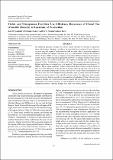| dc.contributor.author | Nyabundi, Karl W | |
| dc.contributor.author | Owuor, P. Okinda | |
| dc.contributor.author | Netondo, Godfrey W. | |
| dc.contributor.author | Bore, John K | |
| dc.date.accessioned | 2018-06-28T11:18:30Z | |
| dc.date.available | 2018-06-28T11:18:30Z | |
| dc.date.issued | 2017 | |
| dc.identifier.citation | Nyabundi, K.W.; Owuor, P.O.; Netondo, G.W.; Bore, J.K. (2017). Yields and nitrogenous fertiliser use efficiency responses of clonal tea (Camellia Sinensis) to locations of production. International Journal of Tea Science, 13 (1&2), 32-40. | en_US |
| dc.identifier.issn | DOI: https://doi.org/10.20425/ ijts.v13i01-02.9983 | |
| dc.identifier.uri | https://repository.maseno.ac.ke/handle/123456789/653 | |
| dc.description.abstract | Tea husbandry practices in Kenya are uniform despite variations in responses to agronomic inputs with locations. Nitrogen availability is the most limiting tea/crop growth factor. However, tea yields vary with region of production even with the same cultivar, suggesting responses to nitrogen fertiliser and nitrogen utilisation may vary with locations. Nitrogen use efficiency (NUE) of clone TRFK 6/8 was investigated across three different locations/environments in western Kenya. Yields responded significantly (pd”0.05) to nitrogen fertiliser rates, but the responses varied with location of production. The responses to nitrogen rates were significantly lower (p<0.05) in Timbilil than in Arroket and Changoi. This suggests that optimal nitrogenous fertiliser application rates should vary with locations. Nitrogen application rates between 75-300Kg N did not cause significant variation in harvestable shoots nitrogen contents. However, there were large differences in the amounts of nitrogen removed with crop. The NUE of tea decreased as nitrogen fertiliser rates increased and was low in areas where yield responses were low. Such areas need low nitrogen fertiliser application rates to justify return on investment. Quantity of nitrogen removed with crop followed same pattern. On replacement basis, nitrogen removed with crop did not exceed the recommended rate of application (150 kg N/ha/year) at any location or nitrogen rate. Shoot nitrogen contents suggest that soil applied nitrogen may not be responsible for locational variations in yield realisation. Results demonstrate that fertiliser management practices, especially nitrogen rates need to be location specific. | en_US |
| dc.description.sponsorship | Inter-University Council of East Africa (Lake Victoria Research Initiative(VicRes)), National Council of Science and Technology (NACOSTI) and the Tea Research Institute, Kenya | en_US |
| dc.publisher | International Journal of Tea Science Vol 13, No. 1&2 (2017) : 32-40 | en_US |
| dc.relation.ispartofseries | ;DOI: https://doi.org/10.20425/ ijts.v13i01-02.9983 | |
| dc.subject | Environment, Location, Yields, Nitrogen use efficiency, Nitrogen content | en_US |
| dc.title | Yields and Nitrogenous Fertiliser Use Efficiency Responses of Clonal Tea (Camellia Sinensis) to Locations of Production | en_US |
| dc.type | Article | en_US |

